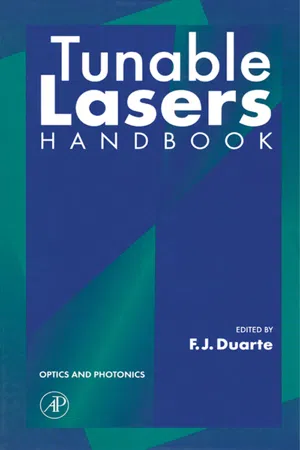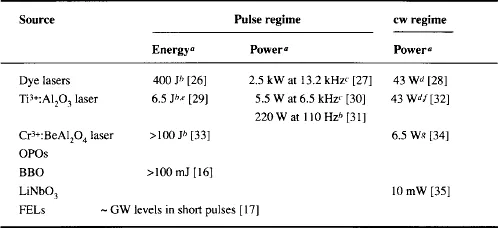
- 477 pages
- English
- ePUB (mobile friendly)
- Available on iOS & Android
eBook - ePub
Tunable Lasers Handbook
About this book
Many laser applications depend on the ability of a particular laser to be frequency tunable. Among the many different types of frequency tunable lasers are: dye lasers, excimer lasers, and semiconductor lasers. Thisbook gives active researchers and engineers the practical information they need to choose an appropriate tunable laser for their particular applications.
- Presents a unified and integrated perspective on tunable lasers
- Includes sources spanning the electromagnetic spectrum from the UV to the FIR
- Contains 182 figures and 68 tables
- Provides coverage of optical parametric oscillators and tunable gas, liquid, solid state, and semiconductor lasers
Frequently asked questions
Yes, you can cancel anytime from the Subscription tab in your account settings on the Perlego website. Your subscription will stay active until the end of your current billing period. Learn how to cancel your subscription.
At the moment all of our mobile-responsive ePub books are available to download via the app. Most of our PDFs are also available to download and we're working on making the final remaining ones downloadable now. Learn more here.
Perlego offers two plans: Essential and Complete
- Essential is ideal for learners and professionals who enjoy exploring a wide range of subjects. Access the Essential Library with 800,000+ trusted titles and best-sellers across business, personal growth, and the humanities. Includes unlimited reading time and Standard Read Aloud voice.
- Complete: Perfect for advanced learners and researchers needing full, unrestricted access. Unlock 1.4M+ books across hundreds of subjects, including academic and specialized titles. The Complete Plan also includes advanced features like Premium Read Aloud and Research Assistant.
We are an online textbook subscription service, where you can get access to an entire online library for less than the price of a single book per month. With over 1 million books across 1000+ topics, we’ve got you covered! Learn more here.
Look out for the read-aloud symbol on your next book to see if you can listen to it. The read-aloud tool reads text aloud for you, highlighting the text as it is being read. You can pause it, speed it up and slow it down. Learn more here.
Yes! You can use the Perlego app on both iOS or Android devices to read anytime, anywhere — even offline. Perfect for commutes or when you’re on the go.
Please note we cannot support devices running on iOS 13 and Android 7 or earlier. Learn more about using the app.
Please note we cannot support devices running on iOS 13 and Android 7 or earlier. Learn more about using the app.
Yes, you can access Tunable Lasers Handbook by Frank J. Duarte in PDF and/or ePUB format, as well as other popular books in Scienze fisiche & Materia condensata. We have over one million books available in our catalogue for you to explore.
Information
1
Introduction
F.J. Duarte, Eastman Kodak Company Rochester, New York
1. INTRODUCTION
Tunable sources of coherent radiation are suitable for a wide range of applications in science, technology, and industry. For instance, the first broadly tunable laser source, the dye laser, is used for a plethora of applications in many diverse fields [1] including physics [2–4], spectroscopy [5, 6], isotope separation [6–8], photochemistry [9], material diagnostics [9], remote sensing [9–11], and medicine [12]. In addition to issues of physics, it is this utilitarian aspect of tunable lasers that motivates much of the interest in the field.
In recent years, new sources of tunable coherent radiation have become available that have either extended spectral coverage or yielded appealing emission characteristics. Notable among these sources are optical parametric oscillators and tunable semiconductor lasers.
This field has several natural subdivisions. For instance, although most sources of tunable coherent radiation are lasers, some sources such as the optical parametric oscillator (OPO) do not involve population inversion. An additional classification can be established between broadly tunable sources of coherent radiation, including broadly tunable lasers, and discretely tunable lasers, and/or line-tunable lasers. A subsequent form of classification can be the physical state of the different gain media such as gaseous, liquid, and solid state. Further avenues of differentiation can include the required method of excitation and the mode of emission, that is, pulsed or continuous wave (cw). Moreover, sources of tunable coherent radiation can be further differentiated by the spectral region of emission and energetic and/or power characteristics. Also, in the case of pulsed emission, pulse duration, and pulse repetition frequency (prf) are important.
The spectral coverage available from pulsed broadly tunable sources of coherent radiation is listed in Table 1. The spectral coverage available from cw broadly tunable lasers is given in Table 2 and emission wavelengths available from discretely tunable lasers are listed in Table 3 of Chapter 5. The information provided in these tables indicates that broadly tunable sources of coherent radiation span the electromagnetic spectrum from ∼300 nm to ∼1 mm. Excimer lasers offer limited tunability in regions further into the ultraviolet around 193 and 248 nm. The tuning ranges quoted for ArF and KrF lasers are ∼17, 000 GHz and ∼10, 500 GHz [24], respectively. An exception among excimer lasers is the XeF laser with its C→A transition, which has demonstrated broadly tunable emission in the 466- to 512-nm range [25]. In Table 3 of Chapter 5 bandwidth and tuning range information is included for a variety of discretely tunable lasers including excimer, N2, HgBr, and Cu lasers. Wavelength information on line-tunable cw lasers such as Ar+ and the Kr+ lasers is included in Table 11 of Chapter 5. Energetic and power characteristics of some tunable sources of coherent radiation are listed in Table 3 of this chapter. Although the title of this book refers specifically to tunable lasers, sources that do not involve population inversion in their generation of coherent radiation are included. This approach is justified because the issue under consideration is the generation of tunable coherent radiation, which is precisely what OPOs perform.
TABLE 1
Wavelength Coverage Available from Pulsed Broadly Tunable Sources of Coherent Radiation
| Source | Wavelength range |
| Dye lasers | 320–1200 nma [13] |
| Ti3+:A12O3 laser | 660–986 nm [14] |
| Cr3+:BeAl2O4 laser | 701–818 nm [15] |
| OPO | |
| BBO | 0.41–2.7 μm [16] |
| Free-electron lasers (FELs) | 2μm–1 mmb [17] |
aWavelength range covered with the use of various dyes.
bCombined wavelength range from several free-electron lasers.
TABLE 2
Wavelength Coverage Available from cw Broadly Tunable Lasers
| Laser source | Wavelength range |
| Dye lasers | 320–1000 nma [18] |
| Ti3+:A12O3 laser | 710–870 nmb[19] |
| Semiconductor lasersc | |
| InGaAsP/InP | 55 nm at 1500 nm [20] |
| InGaAsP/InP | 1255–1335 nm [21] |
| GaAlAs | 815–825 nm [22] |
| GaAlAs | 20 nm at 780 nm [23] |
aWavelength range covered with the use of various dyes.
bWavelength range of single-longitudinal-mode emission. Tuning range limited by coatings of mirrors [19]. Commercial designs offer extended tuning ranges beyond 1000 nm.
cWavelength tuning achieved using external cavity designs.
TABLE 3
Energy and Power Characteristics from Broadly Tunable Sources of Coherent Radiation

aThese values may represent the best published performance in this category.
bUnder flashlamp excitation.
cUnder copper–vapor–laser (CVL) excitation.
dUnder Ar+ laser excitation.
eUs...
Table of contents
- Cover image
- Title page
- Table of Contents
- OPTICS AND PHOTONICS (fonnerly Quantum Electronics)
- Tunable Lasers HANDBOOK
- Copyright
- Contributors
- Preface
- Chapter 1: Introduction
- Chapter 2: Narrow-Linewidth Laser Oscillators and Intracavity Dispersion
- Chapter 3: Tunable Excimer Lasers
- Chapter 4: CO2 Isotope Lasers and Their Applications in Tunable Laser Spectroscopy
- Chapter 5: Dye Lasers
- Chapter 6: Transition Metal Solid-State Lasers
- Chapter 7: Optical Parametric Oscillators
- Chapter 8: Tunable External-Cavity Semiconductor Lasers
- Chapter 9: Tunable Free-Electron Lasers
- Index